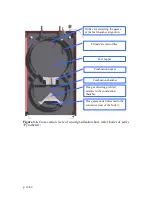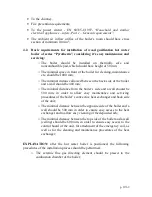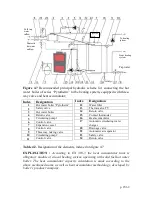
p. 29/69
ash, result of wood logs combustion could be considered as soil fertilizer and
dispersed for agricultural purposes for example;
•
After the end of each heating season, the boiler, as well as the chimney and
the other systems modules should be thoroughly cleaned from the deposited
ash, tars, etc, if necessary service maintenance should be performed as well;
•
The duration of the boiler’s operation depends on the operating mode of the
unit, as well the properties of the wood, being chosen as fuel. The practice
shows that wood of type : beech, oak, ash (fraxinus), sycamore, fruit-trees
are materials, which allow relatively high duration of the boiler’s operation
and thus longer period between two fuel charging of the boiler’s hopper,
because their specific heating value (the calorific value, considered on the
fuel volume) ir relatively higher, compared to the other types of wood fuel.
The next (considering the calorific value) wood materials, which have lower
specific calorific value of the fuel are : chestnut-tree, birch, pine spruce –
they are considered as second grade of quality, considering their calorific
values and combustion characteristics. The materials of : lime-tree, poplar,
willow, elm-tree has lowest quality, considered as fuel, because of their
lowest specific volume heating value. Also the contents of resin and tat in
the wood material will lead to lower quality fuel, as these contents lead to
high degree of combustion chamber contamination and lower heat
exchanging rates. It should be considered, that the raw wood material (which
has high moisture content) have low heating value and will lead to high fuel
consumption rates and low boiler’s efficiency. These operating modes could
lead to intensive chemical corrosion of the heat exchanging surfaces as well,
mainly due to the deposited tar particles and organic acids formation.;
The wood gasification hot water boiler of series “Pyrotherm” is fuel
manually charged boiler. The boiler’s thermal capacity strongly depends on the
fuel properties, mainly its moisture contents, as well as boiler’s operating mode.
The practice shows that efficient pyrolisis process in such type of hot water
boilers is achieved at temperature levels of the circulating water above 60
o
C.
That’s why one of the main requirements for the efficient operation of this type
of boilers is to control the thermal capacity of the boiler and the outflow heat
consumption in order to sustain such temperature levels of the water in the
boiler. In case that the water temperature is below the above mentioned levels,
this will lead to low intensity of volatile gases, released from the wood in the
fuel hopper, as well as intensive condensation of the tars on the heat exchanging
surfaces of the boiler. This process is highly inefficient and decreases the overall
lifetime and reliability of the boiler. The condensed tars form organic acids,
which act highly corrosive on the heat exchanger surfaces as well (finally the
heat exchanger’s wall will be thinned and eventually will be cracked and water
leakage will be observed). The practice shows that during the nominal operation
















































